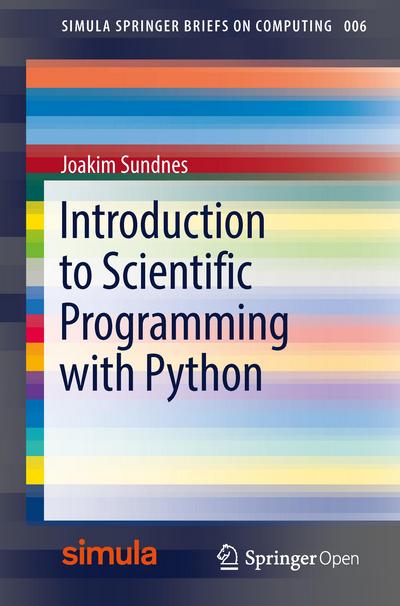
Introduction to Scientific Programming with Python
A compact introduction to scientific programming. No prior knowledge of programming is needed.
Publication date: 01 May 2020
ISBN-10: n/a
ISBN-13: n/a
Paperback: 157 pages
Views: 16,133
Type: Book
Publisher: Springer-Verlag GmbH
License: Creative Commons Attribution 4.0 International
Post time: 27 Feb 2021 06:00:00
Introduction to Scientific Programming with Python
 A compact introduction to scientific programming. No prior knowledge of programming is needed.
A compact introduction to scientific programming. No prior knowledge of programming is needed.
Tag(s):
Computer Aided Mathematics
Mathematics
Python
Publication date: 01 May 2020
ISBN-10: n/a
ISBN-13: n/a
Paperback: 157 pages
Views: 16,133
Document Type: Book
Publisher: Springer-Verlag GmbH
License: Creative Commons Attribution 4.0 International
Post time: 27 Feb 2021 06:00:00
Publication date: 01 May 2020
ISBN-10: n/a
ISBN-13: n/a
Paperback: 157 pages
Views: 16,133
Document Type: Book
Publisher: Springer-Verlag GmbH
License: Creative Commons Attribution 4.0 International
Post time: 27 Feb 2021 06:00:00
Summary/Excerpts of (and not a substitute for) the Creative Commons Attribution 4.0 International:
You are free to:
Share — copy and redistribute the material in any medium or format
Adapt — remix, transform, and build upon the material for any purpose, even commercially.
The licensor cannot revoke these freedoms as long as you follow the license terms.
Click here to read the full license.
Share — copy and redistribute the material in any medium or format
Adapt — remix, transform, and build upon the material for any purpose, even commercially.
The licensor cannot revoke these freedoms as long as you follow the license terms.
Click here to read the full license.
From the Preface:
Joakim Sundnes wrote:
Joakim Sundnes wrote:
This book was originally written as a set of lecture notes to the book A Primer on Scientific Programming with Python by Hans Petter Langtangen1, and can be used either as a supplement to that book or on its own, as a compact introduction to scientific programming. Langtangen's book and these lecture notes, have formed the core of an introductory course on scientific programming at the University of Oslo (INF1100/IN1900, 10 ETCS credits). The course has been running since 2007 and is primarily taken by first-year students of mathematics, engineering, physics, chemistry, and geosciences.
The writing of these lecture notes, and their subsequent evolution into a book, were primarily motivated by two factors. The first was that many students found the nearly 1000 pages of Langtangen's book a bit overwhelming as a first introduction to programming. This effect could be mostly psychological, since the book is well structured and suited for selective study of chapters and sections, but the student feedback from students still indicated the need for a more compact and (literally) lightweight introduction. The second factor was that, sadly, Hans Petter Langtangen passed away in 2016, and his book has therefore not been updated to the newest versions of Python and the various tools introduced in the book. This issue could also be mostly a mental obstacle, since the differences between the Python versions are quite small, and only minor edits are needed to make most of the examples from the original book run on the newest Python platform. However, the book is intended as an introduction to programming, and when learning an entirely new topic, any minor inconsistency is a potential source of confusion. I therefore saw the need for an updated document where all the code examples would run without any modifications on the most common Python platforms. That said, in spite of these minor shortcomings as an introductory text, Langtangen's book is still an excellent resource on scientific programming in Python. Compared with the present book, it covers a much broader set of topics and includes more examples, more detailed discussions and explanations, and many more useful programming hints and tips. I highly recommend it as a supplement to these notes for anyone with ambitions to become an expert scientific programmer.
Tweet
About The Author(s)
Book Categories
Computer Science
Introduction to Computer Science
Introduction to Computer Programming
Algorithms and Data Structures
Artificial Intelligence
Computer Vision
Machine Learning
Neural Networks
Game Development and Multimedia
Data Communication and Networks
Coding Theory
Computer Security
Information Security
Cryptography
Information Theory
Computer Organization and Architecture
Operating Systems
Image Processing
Parallel Computing
Concurrent Programming
Relational Database
Document-oriented Database
Data Mining
Big Data
Data Science
Digital Libraries
Compiler Design and Construction
Functional Programming
Logic Programming
Object Oriented Programming
Formal Methods
Software Engineering
Agile Software Development
Information Systems
Geographic Information System (GIS)
Mathematics
Mathematics
Algebra
Abstract Algebra
Linear Algebra
Number Theory
Numerical Methods
Precalculus
Calculus
Differential Equations
Category Theory
Proofs
Discrete Mathematics
Theory of Computation
Graph Theory
Real Analysis
Complex Analysis
Probability
Statistics
Game Theory
Queueing Theory
Operations Research
Computer Aided Mathematics
Supporting Fields
Web Design and Development
Mobile App Design and Development
System Administration
Cloud Computing
Electric Circuits
Embedded System
Signal Processing
Integration and Automation
Network Science
Project Management
Operating System
Programming/Scripting
Ada
Assembly
C / C++
Common Lisp
Forth
Java
JavaScript
Lua
Rexx
Microsoft .NET
Perl
PHP
R
Python
Rebol
Ruby
Scheme
Tcl/Tk
Miscellaneous
Sponsors
